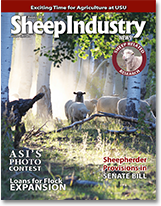To View the December 2013 Digial Issue — Click Here
Putting the Bucks In, Look Forward to Next Year
Clint Krebs, ASI President
In the next few weeks we will be weaning our lambs. Some will go direct for processing and some will be placed on feed. It has been a good year as far as production goes in our area of the country, but as I think back, I really can find something good to say about every year. Weaning and shipping lambs represents the end of the cycle, and shaping up the ewe flock to begin breeding for next year’s lamb crop is the start of the next cycle. There have been years in the past with better lamb weights and there have been lower lamb weights. There have been years with higher prices and a lot of years with lower prices. Every year is different, and when I say there is something good in every year, sometimes it is just surviving the challenges – from drought, to high lamb losses and poor prices – that are thrown upon us. Most sheep producers know exactly what I am talking about, we won another round in the fight, and if we put the rams in we will start the next round.
Today’s lamb prices are below the cost of production, so making the decision for next year will be tough. There are many reasons for these poor prices, and no one easy answer in how to make them improve, but certainly the political decision to mandate the use of corn to make ethanol as a replacement for gasoline is a very big part. At the time the Renewable Fuels Act (RFA) was passed, we were very dependent of Middle Eastern oil and we had an abundance of corn in our back yard. In fact, we were actually paying corn farmers to not grow corn. Today the cards are different. We are putting so many bushels of corn into our gas tanks, we have become dependent on Mother Nature to provide great growing conditions to produce record corn crops every year; instead of dependent on the Middle East to provide favorable oil pricing and production decisions. Right now, those of us, not just sheep producers, who feed corn to livestock, are taking the financial hit for the decision to implement the RFA, but what the act has done, is tie the price of energy – oil – to the price of food. There are very few items in today’s shopping cart that do not have some corn component. Think about it? As oil goes up, the food prices have to rise. Sooner or later the consumer will have to start making the decision if they want to eat, or if they want to drive. The United States has always been lucky to have the cheapest food in the world as compared to the net income of its consumers and I believe they, when forced to, will choose to eat over choosing to burn corn in their car. This is why I am putting the bucks in, and looking forward to next year.
I was recently visiting with some sheep producers from Texas and they were talking about the difficulty of driving a Dodge dually pick-up with a 24-foot gooseneck trailer through a “double-bang” gate. I had never heard the term double-bang gate and assumed they were referring to the sounds I hear when going through a gate. That is of my wife slamming the door as she gets out to open the gate, and then the muttering under her breath as she recites her wedding vows while she struggles to open and close the gate. The second slam is when she gets back in. The Texans then started talking about just a bang gate so I had to ask what they were talking about. They explained that you bang the gate with your pickup bumper and drive through, hopefully before the gate closes itself. They even drew me a diagram so I could go home and build my own. I fully intended to do so until I realized that if I did not provide a good work out on the ranch for my wife, she would be burning more corn in her car going to town and then buying a gym membership.


